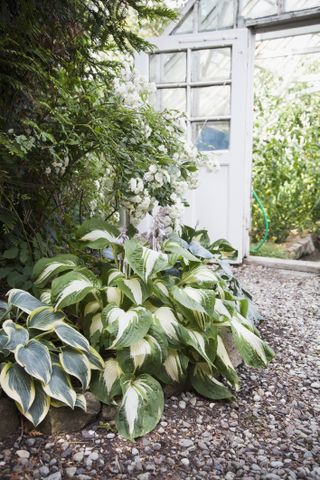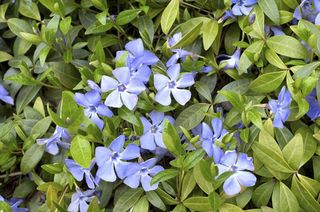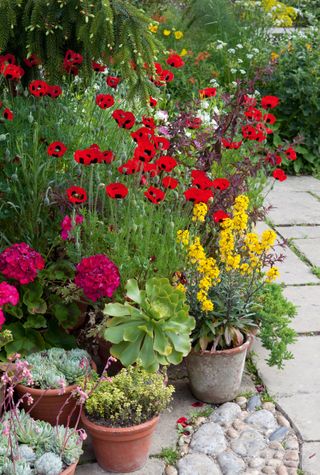
Choosing plants is one the most important steps in any new garden design or outdoor space transformation and the right garden plant ideas for your space will depend on a multitude of different factors. From knowing how much room you have, to understanding your garden's aspect, the different soil types and the look you want to create, of course, there's lots of exciting stuff to consider when forming your planting scheme.
From colorful patio plants, to flowers that will still bloom on a small and shady balcony, to the perfect perennials for an urban outdoor space, take a look at our practical guide on how to perfect your planting scheme.
- Want to know more on gardening for beginners? We can help.
1. Start by assessing the size of your outdoor space

Most plants need space and if you don't let them have their own little piece of territory, there may be hell to pay. Be realistic with your garden plant ideas by starting simply with a tape measure, piece of paper and a ruler to measure up the size of your plot. If you plan on container gardening, think about this too and measure up what you have to see how everything will slot into place.
This is a really important first step to allow you to make decisions about scale, furniture and any other areas for hard standing and lawn. Once you've got your facts straight, know how much room you actually have to grow things plus, where you want your garden borders and beds to be, you will have a clear idea of what you can achieve in your planting scheme.
- Find all the best garden ideas in our ultimate gallery.
2. Work out your soil type

Soils will either be pH neutral with a value of 7.0, anything below that is classed as acid and anything above, alkaline. Different types of garden plants will thrive in different soils and there are some simple things you can do just by looking around your plot to work out what you soil's acidity is. For example, if rhododendron and camellia grow well in your neighborhood, then the likelihood is that your soil is pH neutral to acidic, so look out for plants that have this information on the label.
You can also alter the acidity of your soil to cater to and alter the visual outcome of certain plants. If you are growing hydrangea for example and want blue petals, then you will need acidic soil. And, if you'd like pink hydrangea, a more alkaline soil will help you achieve that.
You can of course buy simple pH test soil kits in most good garden centres, which are easy to operate and provide useful information to base your planting scheme around.
Next, the texture and consistence of your soil is very important also as it will determine the level of nutrition and drainage which again is specific to different types of plant. These are the six main soil groups:
- Clay: Will clump together (in the name) it has poor drainage but is good for many evergreens like asters, shrubs and even some vegetables.
- Sandy: Loose soils that do not hold together in your hand which means they are quick to dry out and take their nutritional value with them. Tulips do well in sandy soils much like rooted vegetables like carrots and parsnips.
- Silty: Is soft, soapy and can be easily compacted, making it ideal for grasses and moisture-loving trees like Willows, and shrubs. You can improve the drainage with organic matter also.
- Peaty: Soil is spongy and darker in color. It's good for growing vegetables and will keep shrubs like rhododendron and camellia happy too.
- Chalky: This is a fairly stoney type which is good for trees, shrubs and many bulbs. Vegetables such as spinach and cabbage will also do well.
- Loamy: Often regarded as the best soil type for gardeners as it blends the defining characteristics of all the other soil types making it fine in texture, damp enough and with good structure.

- Learn how to compost in our guide.
Once you know what your soil type is you can consider any garden plant ideas with more knowledge and be confident your plants will grow well. When designing an outdoor space, always remember the mantra of ‘right plant, right place’. Spend time selecting your plants carefully; read labels and thoroughly research plant/soil type suitability, and you will be rewarded.
3. Get to know your garden aspect

Work out the aspect of your plot and consider the following species to match your garden planting scheme:
- North-facing: Hydrangea petiolaris, Sarcococca confusa, Mahonia vars, Liriope muscar, Hosta vars.
- South-facing: Agapanthus Headbourne Hybrids, Allium vars, ornamental grasses, Salvia nemerosa ‘Caradonna’, pelargoniums, lavender, and poppies.
- West- or east-facing: These gardens can usually accommodate most plants, as they provide enough sunlight without getting as hot as south-facing gardens. So, get creative with a mixture of all the above.
4. Consider your garden's climate

Do you live close to the sea and enjoy a light salty breeze at the best of times? Or, do you have an urban garden that is likely on the polluted side of the environment? It's important to think about this level of detail as it will determine how hardy your garden plant ideas need to be. You don't want to plant pansies (not the best example as they are actually fairly hardy) only to find that a gust of wind pulled them up – in summer.
- These are the best pollution tolerant plants.
5. And, think about any garden visitors

Visitors go further than just slugs... You need to think about any pets that are likely to dig up or chew plants, like foxes, badges or rabbits, that have made your garden part of their habitat/usual stomping ground to ensure that you can both protect your planting and keep those visitors safely at bay. Take into account any poisonous varieties that could be fatal to your or a neighbor's cat or dog, like lilies for example, as you will want to completely omit these from your garden planting ideas. And, if you know you have hedgehogs, lots of garden birds, insects and more, and want to encourage them in, you should consider this in your planting also.
- Find all our bee-friendly gardening tips here.
6. Know your shadiest areas

There is light-dappled shade and pitch-dark shade – and every level of shade in between. Many of the best shade plants will do well in light shade are more common garden plants than you might think; hydrangea, viburnum, paeonia and even some roses. Plants for dense heavy shade are much more difficult and often not as exciting, though still good for working into your garden design; aucuba, vinca, ferns and hosta are all worth considering – they’ll give the space plenty of greenery and substantial ‘body’, as some can be quite large.
Often shade goes hand in hand with dryness, as large trees take up lots of water and nutrients so shady areas can take longer to establish, so patience is vital with all garden plant ideas.

Great garden plant ideas for areas that are heavily shaded for most of the day, vinca will add structure to your planting scheme throughout the year
7. Know your sunny and hot spots

Sun-loving garden plant ideas outnumber shade-loving ones in the world of horticulture as they tend to be those that have the most color. The world is almost your oyster here if you’re lucky enough to have a garden that benefits from sun all day. Look out for lavandula, salvia, penstemon, roses, geraniums, verbena and herbs, which all like sun. And, why not go to town with a Mediterranean garden scheme too?
8. Plant in numbers for a successful planting scheme

Always bear the rule ‘right plant, right place’ in mind; also, plant in bulk numbers for maximum impact. Group garden plants in threes or fives or if you have more room multiples of odd numbers to create broad swathes of color. Don’t be afraid to fill gaps in beds with plants and flowers – the most beautiful flower bed ideas, borders and pots are teaming with color and multiple heights.
9. Aim for year-round interest with evergreens

Garden plant ideas that look good in the winter will only look better in the summer. Think of green as a color in its own right and embrace it as your winter backdrop. A high percentage of evergreen plants will provide a backbone for your scheme. Evergreens also will act as foils to summer color and provide a feeling of a well-established plot. Plants such as cornus that have colourful winter stems are good too. When the warmer spring and summer months arrive, look to update beds, baskets, pots and troughs with seasonal flowers, and plant spring flower bulbs, such as tulips and daffodils in winter for a nice boost of colour in early spring.
- Discover the best winter plants for added interest in all seasons.
10. Think low maintenance but visually appealing

Finally, always think about how much time you have available – and want to dedicate – to maintaining your garden planting ideas for a better chance at keeping your outdoor space looking its best.
There are plenty of low maintenance garden ideas for people who prefer a garden that sustains itself a little. For example, topiary is remarkably easy and box plants only really need clipping once or twice a year. Choose easy-to-care-for options that add visual drama and interesting focal points, that will also form a good sound backdrop to any planting scheme. Also, if you tend to forget to water your garden, choose plants that are comfortable without being watered too often – lavender and pelargoniums are a great choice, as well as shamrocks. If you are a beginner, you may choose to hold off growing roses, as they are notoriously high-maintenance.
Time to put our garden plant ideas into practice.
Join our newsletter
Get the best home decor ideas, DIY advice and project inspiration straight to your inbox!
- Camille Dubuis-WelchFormer Deputy Editor